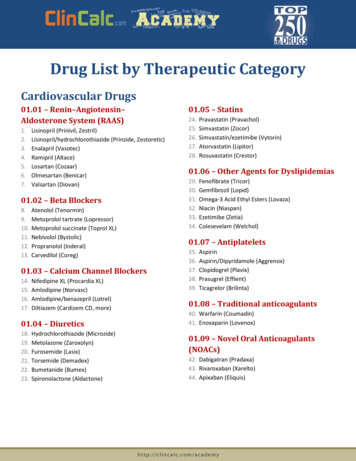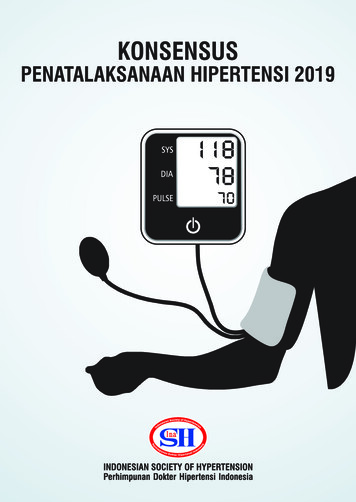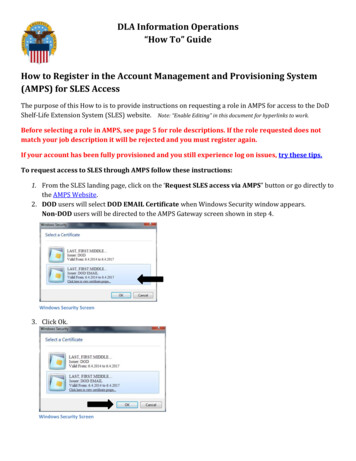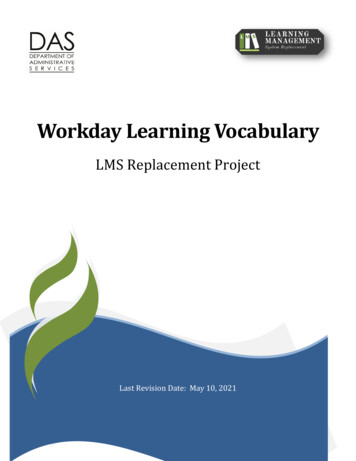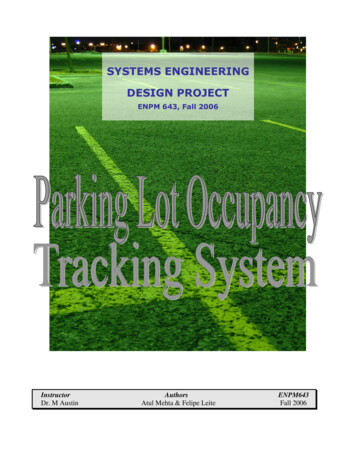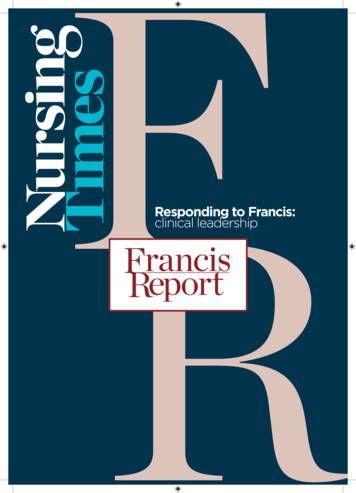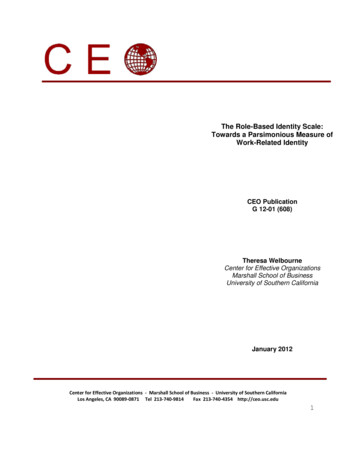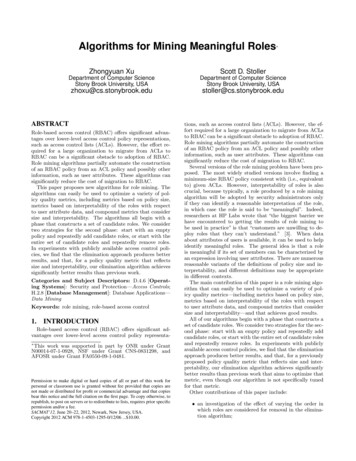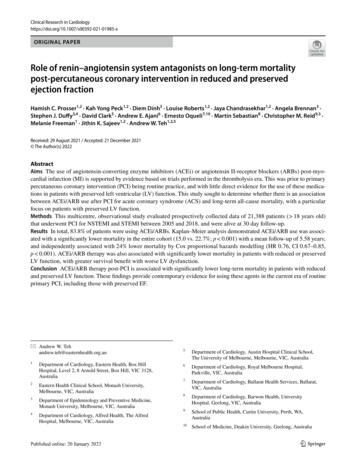
Transcription
Clinical Research in -xORIGINAL PAPERRole of renin–angiotensin system antagonists on long‑term mortalitypost‑percutaneous coronary intervention in reduced and preservedejection fractionHamish C. Prosser1,2 · Kah Yong Peck1,2 · Diem Dinh3 · Louise Roberts1,2 · Jaya Chandrasekhar1,2 · Angela Brennan3 ·Stephen J. Duffy3,4 · David Clark5 · Andrew E. Ajani6 · Ernesto Oqueli7,10 · Martin Sebastian8 · Christopher M. Reid9,3 ·Melanie Freeman1 · Jithin K. Sajeev1,2 · Andrew W. Teh1,2,5Received: 29 August 2021 / Accepted: 21 December 2021 The Author(s) 2022AbstractAims The use of angiotensin-converting enzyme inhibitors (ACEi) or angiotensin II-receptor blockers (ARBs) post-myocardial infarction (MI) is supported by evidence based on trials performed in the thrombolysis era. This was prior to primarypercutaneous coronary intervention (PCI) being routine practice, and with little direct evidence for the use of these medications in patients with preserved left ventricular (LV) function. This study sought to determine whether there is an associationbetween ACEi/ARB use after PCI for acute coronary syndrome (ACS) and long-term all-cause mortality, with a particularfocus on patients with preserved LV function.Methods This multicentre, observational study evaluated prospectively collected data of 21,388 patients ( 18 years old)that underwent PCI for NSTEMI and STEMI between 2005 and 2018, and were alive at 30 day follow-up.Results In total, 83.8% of patients were using ACEi/ARBs. Kaplan–Meier analysis demonstrated ACEi/ARB use was associated with a significantly lower mortality in the entire cohort (15.0 vs. 22.7%; p 0.001) with a mean follow-up of 5.58 years;and independently associated with 24% lower mortality by Cox proportional hazards modelling (HR 0.76, CI 0.67–0.85,p 0.001). ACEi/ARB therapy was also associated with significantly lower mortality in patients with reduced or preservedLV function, with greater survival benefit with worse LV dysfunction.Conclusion ACEi/ARB therapy post-PCI is associated with significantly lower long-term mortality in patients with reducedand preserved LV function. These findings provide contemporary evidence for using these agents in the current era of routineprimary PCI, including those with preserved EF.* Andrew W. Tehandrew.teh@easternhealth.org.au1Department of Cardiology, Eastern Health, Box HillHospital, Level 2, 8 Arnold Street, Box Hill, VIC 3128,Australia2Eastern Health Clinical School, Monash University,Melbourne, VIC, Australia3Department of Epidemiology and Preventive Medicine,Monash University, Melbourne, VIC, Australia4Department of Cardiology, Alfred Health, The AlfredHospital, Melbourne, VIC, Australia5Department of Cardiology, Austin Hospital Clinical School,The University of Melbourne, Melbourne, VIC, Australia6Department of Cardiology, Royal Melbourne Hospital,Parkville, VIC, Australia7Department of Cardiology, Ballarat Health Services, Ballarat,VIC, Australia8Department of Cardiology, Barwon Health, UniversityHospital, Geelong, VIC, Australia9School of Public Health, Curtin University, Perth, WA,Australia10School of Medicine, Deakin University, Geelong, Australia13Vol.:(0123456789)
Clinical Research in CardiologyGraphical abstractACEi/ARB therapy post PCI for NSTEMI/STEMI is associated with lower long-term mortality21,388 pa ents post PCI for NSTEMI and STEMIACEi/ARB used in 83.8% of pa entsMean follow-up 5.58 years507.7%1013.1%ACEi/ARB40Mortality (%)20Mortality (%)No ACEi/ARB11.6%304.9%20100No ACEi/ARB (n 3462)ACEi/ARB (n 17926)0LVEF 50%LVEF 35-50%LVEF 35%Abbrevia ons: LVEF, le ventricular ejec on frac on; PCI, percutaneous coronary interven on; STEMI, ST-eleva on myocardial infarc on; NSTEMI, Non-STEMIKeywords Angiotensin converting enzyme inhibitors · Angiotensin receptor blockers · STEMI/NSTEMI · Percutaneouscoronary intervention · Heart failureIntroductionOptimal medical therapy plays a critical role in preventingfurther cardiovascular events and improving clinical outcomes following percutaneous coronary intervention (PCI)for ACS [1–3]. As such, international guidelines recommend multiple medications for secondary-prevention including anti-platelet agents, a β-adrenergic receptor blocker(β-blocker), and a statin [4–7]. Angiotensin-convertingenzyme inhibitors (ACEi) or angiotensin receptor blockers (ARBs) are also recommended as first-line therapy inpatients with concomitant heart failure (HF), left ventricular (LV) dysfunction (ejection fraction (EF) 40%), anterior MI, diabetes or hypertension, and in those with stablechronic kidney disease (CKD) [4–8]. Guidelines also recommend that ACEi may be considered for all patients regardless of these associated factors, but this is supported by areduced level of evidence (Class IIa, level A-B evidence)[4–8].The evidence underlying guideline recommendationscomes from large trials mostly performed over 20 years ago,during an era prior to routine and/or primary PCI, wherethrombolysis was often performed, with greater subsequent13mortality compared to the present time. The last 20 yearshave seen major changes in the management of ACS, resulting in a greater proportion of patients with preserved LVfunction, primarily due to increased use of primary PCI, anda routine early invasive strategy in NSTEMI [2, 9].The aims of this study were (1) identify prescribingpractices of RAS inhibitors (ACEi and ARBs) in patientspost-PCI for MI between 2005 and 2018; (2) evaluate thelong-term survival benefits of ACEi/ARBs in an unselected cohort of patients that underwent PCI for STEMI orNSTEMI; (3) determine the effects of ACEi/ARB therapyin patients with reduced and preserved LV function by subgroup analysis.MethodsStudy design and patient populationThis multicenter, observational study utilized prospectivelycollected data from the Melbourne Interventional Group(MIG) registry, an Australian registry that collects comprehensive data on consecutive patients undergoing PCI from
Clinical Research in Cardiologysix major public (government funded) hospitals within Victoria, Australia [10]. Data from a total of 21,388 patientsthat underwent PCI for STEMI and NSTEMI between January 2005 and September 2018 were evaluated. Inclusioncriteria required the patient to be 18 years old, undergoPCI for NSTEMI or STEMI, and be contactable at 30-dayfollow up where their use of ACEi/ARB and clinical outcomes were recorded. Exclusion criteria included patientsthat died prior to, or were not contactable at 30-day followup, and those in which use of ACEi/ARB was not able to bedetermined (discharge medications are not recorded in theMIG registry). Long-term mortality was identified via linkage to the Australian National Death Index, with multiplepatient demographics cross-matched with the MIG registryto identify deceased patients. The ethics committee of eachparticipating hospital had approved registry participation.Consent was obtained in all participants via an “opt-out”model. This study abided by the ethical guidelines of the1975 Declaration of Helsinki.OutcomesThe primary outcome of this study was long-term, all-causemortality. The cohort was stratified by patient LV ejectionfraction (EF) into 35%, 35–50% and 50%. LVEF wasmeasured or estimated within 4 weeks of patient admission,the vast majority during the inpatient stay.Statistical analysisContinuous variables are expressed as mean standarddeviation, with categorical variables expressed as numbersand percentages as indicated. Differences between groupsin discrete variables relating to patient characteristics andclinical outcomes were analyzed by Pearson Chi-squaredtests. All data were tested for normal distribution prior toselecting the appropriate statistical test. Where appropriate,independent sample t tests (for normally distributed data) orKruskal–Wallis equality-of-populations rank tests (for nonnormally distributed data) were used for continuous variables. Survival curves were determined by Kaplan–Meieranalysis, with differences in survival assessed by log-ranktests. A p value of 0.05 was considered to indicate statistical significance. Differences in baseline characteristicswhich may have acted as potential confounders to the analysis were accounted for using Cox proportional multivariablemodelling, as previously published [11]. Variables found tohave a p value 0.10 in the univariable model were considered for inclusion in the multivariable model to identifywhether they remained statistically significant and independent predictors of mortality. The full list of variables includedin this modelling is included in Supplementary Table 1.Statistical analyses were performed using Stata software(Stata 16.0, College Station, TX, USA).ResultsBaseline patient characteristicsBetween 2005 and 2018 23,942 consecutive patients underwent PCI for STEMI or NSTEMI. Of these 2554 wereexcluded and the remaining 21,388 patients alive at 30 dayfollow-up were evaluated (Fig. 1). At 30 days, 17,926patients (83.8%) were taking an ACEi/ARB, while 3462(16.2%) were not (Table 1). At baseline, those who were onACEi/ARB therapy at 30 days were younger, hypertensive,with elevated BMI, and a family history of CAD. The groupnot prescribed ACEi/ARB had significantly more womenand comorbidities including chronic lung disease, prior MI,prior CABG, prior HF, prior valvular surgery, peripheralvascular disease, cerebrovascular disease, renal diseaserequiring dialysis, and rheumatoid arthritis (Table 1).These baseline differences between treatment groups fromthe entire cohort were generally mirrored in the subgroupsEF 35–50% (N 8221) and EF 50% (N 12,091). Fewpatient characteristics differed between treatment groups inthe smaller cohort of patients with EF 35% (N 1076),however, significantly fewer were on ACEi/ARB if hypertensive or a current smoker, and a greater proportion wereon ACEi/ARB in the setting of prior PCI.Prescribing practices of ACEi/ARBs at 30‑dayfollow‑upObserving the use of ACEi/ARBs in all patients post-PCIbetween 2005 and 2018, the proportion of patients receivingACEi/ARB each year fluctuated mildly between 80 and 87%with a small but statistically significant reduction in ACEi/ARB use over the study period (p 0.001), and remainedsignificantly greater than patients not using ACEi/ARB(p 0.001; Fig. 2). Of the 83.8% of patients prescribed anACEi/ARB in this study, 82.8% were prescribed ACEi and18.2% an ARB (Table 2).There were some statistically significant differences inmedication regimens identified between those that were andwere not on ACEi/ARB therapy (Table 2). Patients on ACEi/ARB had a significantly higher proportion also on aspirin,P2Y12 inhibitors, warfarin, eplerenone, β-blocker and statin therapy. Those not prescribed ACEi/ARB were morefrequently prescribed calcium channel blockers, ezetimibe,non-vitamin K oral anticoagulants (NOAC) and nitrate therapy. The use of spironolactone did not differ between thoseon ACEi/ARB therapy or not. The greater prescribing of13
Clinical Research in CardiologyFig. 1 Flow diagram illustratingthe study population and subgroups. ACEi angiotensin converting enzyme inhibitor, ARBangiotensin receptor blocker,EF left ventricular ejection fraction, NSTEMI non-ST-segmentelevation myocardial infarct,STEMI ST-segment elevationmyocardial infarctaspirin, statin, and β-blockers to those on ACEi/ARB wasconsistent across all LVEF subgroups (Table 2).Cardiac status and angiography/PCI characteristicsAll patients underwent PCI, with 87% of STEMI patientson ACEi/ARB therapy at 30 days compared to 80% forNSTEMI (p 0.001; Table 3). A significantly greater proportion of patients were on ACEi/ARB therapy if they hadan out of hospital cardiac arrest, underwent thrombolysis, orhad a successful PCI (Table 3).Clinical outcomesOn Kaplan–Meier analysis of the entire cohort, ACEi/ARB therapy was found to be associated with significantlyreduced mortality (15.0% vs. 22.7%, p 0.001; mean followup 5.58 years; Fig. 3). This significant reduction in mortalitywas also present across each EF subgroup, with ACEi/ARBbeing associated with improved survival by 4.9%, 11.6%and 13.1% in patients with LVEF 50%, 35–50% and 35%respectively, suggesting a trend of increased therapeutic benefit with increasing LV dysfunction (Fig. 3).For the unselected cohort, Cox proportional hazards modelling demonstrated that ACEi and ARB use were independently associated with reduced mortality (Fig. 4, Supplementary Table 1). On subgroup analysis with patients stratifiedby EF%, ACEi/ARB remained independently associatedwith improved survival in those with EF 35–50 and 50%(both p 0.001); however, did not reach significance in thosewith EF 35% despite a trend towards survival benefit (HR0.69, CI 0.45–1.1, p 0.088; Supplementary Table 1). A full13table of all variables analyzed by Cox proportional hazardsmodelling can be found in Supplementary Table 1.DiscussionThe key findings of this study were that (1) the use of ACEi/ARB post PCI for NSTEMI/STEMI is high (83.8%); (2)ACEi/ARB therapy in patients post-PCI for NSTEMI orSTEMI is associated with a significant long-term survivalbenefit; (3) this survival benefit is evident in patients withboth preserved and reduced LV function.Current international guidelines recommend the use ofACEi (or ARBs when ACEi are not tolerated) for patientswith STEMI and NSTEMI with concomitant heart failure,LAD lesion, diabetes, or hypertension, and in those withstable CKD after NSTEMI with Class IA evidence [4–8].Lower levels of evidence support their use outside of thesecriteria [4–8]. The current study found 83.8% of patientswere prescribed ACEi/ARB therapy at 30 days post PCI.Given that 60.8% had hypertension, 43.9% had an EF 50%,21.1% were diabetic, 20.4% had an eGFR 60, and 4.2%had reported heart failure at baseline prior to PCI; while35.5% of presentations involved the left anterior descending or left main coronary arteries, prescribing practicesappear to follow current guidelines. Use of ACEi/ARB alsoappeared to be associated with the severity of the presentation; with ACEi/ARB use significantly greater in thosewho had a STEMI compared to those with a NSTEMI orhad an out-of-hospital cardiac arrest. The greater proportion of patients on ACEi/ARB with STEMI compared toNSTEMI is consistent with the greater level of evidencerecommending their use in patients with STEMI (regardless
Diabetes (%)8.2%5.2%19.6%16.0%17.3%Prior MI (%)52.2%34.8%6.7%0.5%37.5%Prior valvular surgery(%)Family history ofCAD (%)4.1%0.7%Dialysis (%)4.2%8.2%21.8%70.0%117.6 126.92.7% 0.001 0.001 0.0010.0030.259 0.001 0.001 0.0010.003 0.0010.0380.1940.0010.109 0.001 0.0010.449 0.0010.434 0.001 0.0011.5%4.3%31.1%64.6%106.1 .4%60.9%12.5%33.2%33.8%33.0%8.3%21.2%29.5%27.4 5.275.7%65.6 13.0ACEi/ARBsn 897LVEF 35%6.2%19.1%39.0%41.9%150.9 3.6%69.3%12.4%45.2%32.5%22.3%13.4%16.8%30.2%26.1 5.572.1%66.9 13.7 0.001 0.001 0.0010.170.820.090.090.510.01 340.23No ACEi/ARBs p valuen 1790.9%2.2%18.2%79.6%93.4 0%58.6%9.6%32.8%33.4%33.8%5.3%15.8%21.1%28.3 5.279.5%63.5 12.4ACEi/ARBsn 6978LVEF 35–50%5.2%9.5%23.6%66.9%122.7 .0%52.6%12.2%35.3%32.7%32.1%9.2%13.1%22.3%27.2 5.375.1%65.9 13.6 0.001 0.001 0.0010.0010.9940.007 0.0010.0040.0010.0100.0300.2690.0200.195 0.0010.0050.223 0.0010.32 0.001 0.001 0.001No ACEi/ARBs p valuen 12430.6%1.4%17.7%80.9%89.0 9%62.3%9.9%32.8%34.7%32.5%4.8%15.5%20.3%28.8 5.576.4%63.2 12.13.5%6.4%19.4%74.2%111.7 .6%50.5%12.5%32.2%34.1%33.7%7.1%13.4%20.5%27.6 5.473.9%63.6 12.8ACEi/ARBs No ACEi/ARBsn 10,051n 2040LVEF 50% 0.001 0.001 0.0010.4500.148 0.0010.002 0.0010.4730.0330.2150.0740.0050.277 0.001 0.0010.571 0.0010.837 0.0010.0180.233p valueACEi angiotensin converting enzyme inhibitor, ARB angiotensin II receptor blocker, BMI body mass index (kg/m2), CABG coronary artery bypass graft, CAD coronary artery disease, eGFRestimated glomerular filtration rate (mL/min/1.73 m2), HF heart failure, IDDM insulin-dependent diabetes mellitus, LVEF left ventricular ejection fraction, MI myocardial infarction, NIDDMnon-IDDM, OSA obstructive sleep apnea, PCI percutaneous coronary intervention, PVD peripheral vascular disease18.6%1.8%eGFR 30 to 60 (%)eGFR 30 (%)91.5 57.279.6%Baseline creatinineeGFR 60 (%)3.7%1.9%OSA (%)Rheumatoid arthritis(%)6.5%4.5%CerebrovascularDisease (%)3.8%4.6%2.7%PVD (%)Prior HF (%)1.2%5.8%15.1%5.0%Prior PCI (%)Prior CABG (%)56.4%60.8%57.8%Hypertension (%)Dyslipidemia (%)12.4%33.9%32.8%9.9%Never smoked (%)Chronic lung disease(%)33.5%33.0%34.2%Current (%)32.6%13.5%15.8%Previous (%)Smoking statusIDDM (%)NIDDM (%)27.4 5.428.6 5.421.0%BMI (kg/m2)21.7%64.6 13.274.2%63.5 12.377.5%Age (years)Male sex (%) 0.001No ACEi/ARBs p valuen 3462ACEi/ARBsn 17,926All patientsTable 1 Patient baseline characteristicsClinical Research in Cardiology13
Clinical Research in CardiologyFig. 2 ACEi/ARB use acrossthe study period 2005–2018.The total rate of ACEi/ARB useis 83.8% (p 0.001 versus noACEi/ARB use). The trend overtime shows a small but significant decline in ACEi/ARB use(p 0.001). ACEi angiotensinconverting enzyme inhibitor, ARB angiotensin receptorblockerof LV function) as per ACC/AHA guidelines. Notably, thisevidence was obtained during the pre-PCI era [4, 8]. Recentevidence supports this prescribing practice in which RASinhibition provided greater survival benefit in 6,762 pairsof unselected and propensity score-matched Korean patientswith STEMI vs. NSTEMI patients 2-years post-PCI in anobservational study [12].The present study found that ACEi/ARB therapy wasassociated with significantly reduced long-term all-causemortality in patients post-PCI for MI by Kaplan–Meierand Cox proportional hazards analyses of the entire cohort.This is consistent with original reports undertaken priorto PCI becoming standard practice. More recent smallercohort studies have provided data in the current PCI era,where ACEi/ARB therapy was associated with significantlyreduced 4-year all-cause mortality in 813 unselected andpropensity-matched pairs of patients post-PCI for NSTEMIin Spain [13]; and was associated with significantlyimproved 5-year survival in 5563 unselected and propensitymatched Japanese patients presenting with MI (with 80%of patients treated with PCI) [14].There is currently less direct evidence supporting ACEi/ARB in patients with preserved LV function followingPCI for a MI. Thus, the current study stratified patientsby EF% (EF 35%, 35–50% and 50%) and revealedthat ACEi/ARB therapy was associated with significantlyhigher survival across all subgroups irrespective of LVEFon Kaplan–Meier analysis. This provides important contemporary evidence to support ACEi/ARB therapy use inall patients post-PCI for STEMI/NSTEMI, regardless of LVfunction, with particular relevance to the modern era of earlyrevascularization with primary PCI. Cox proportional hazards modelling demonstrated that ACEi/ARB therapy wasindependently associated with improved survival for thosewith EF 35–50 and 50%, but despite a clear trend, did notreach significance in those with EF 35%, likely attributableto the smaller sample size in this subgroup.Analysis of ACEi and ARB therapy by Cox proportionalmodelling revealed each to be associated with a statisticallysignificant survival benefit for the entire unselected cohort.Strong evidence exists for ACEi use in reducing mortalityin LV dysfunction post MI in the pre-PCI era [15–17], while13evidence for the use of ACEi in those with preserved LVfunction post MI has been an area of debate. HOPE andEUROPA placebo-controlled trials in patients with stable CAD and without heart failure reported ACEi to significantly reduce mortality; however only 52% and 64% ofpatients had a prior MI, and just 18% and 55% had undergone revascularization in each trial, respectively [18, 19].In contrast, the placebo-controlled PEACE trial found theACEi Trandolapril to have no significant survival benefitin patients with stable CAD without heart failure, but againcontained low rates of prior MI (55%) and PCI (42%) [20].Trials focused on investigating the effect of ACEi/ARB insecondary prevention with preserved LV function are scarce,with one placebo-controlled study of 406 Japanese patientswith a history of coronary intervention and preserved LVEFreporting Candesartan significantly reduced cardiovascular death (RR 0.47; 95% CI 0.24–0.93, p 0.03) [21]. Incontrast, a more recent study of 988 patients with STEMIand preserved EF that underwent PCI showed no longterm survival benefit of ACEi/ARB therapy after a medianof 4.6 years (HR 0.86, CI 0.56–1.33, p 0.50) [22]. Thereasons why that study conflicts with the current findingsmay be due to the much smaller sample size, and exclusionof patients with eGFR 60 mL/min/1.73 m2 or NSTEMI.Furthermore, differences in study period (2002–2011 vs.2005–2018) may also account for the variation in results dueto changes in PCI practices. Recent prospective cohort andobservational studies report ACEi and ARB therapy wereeach associated with significant and comparable survivalbenefits in patients presenting with STEMI and NSTEMIthat underwent PCI in patients with preserved LV function[23, 24]. Taken together, both the current and recent relevantstudies support the use of ARBs/ACEi in patients post PCIwith preserved EF.The efficacy of ACEi–ARB in modifying outcomesafter PCI rely upon tolerance to these medications. Themost common causes of intolerance include drug reactions,hypotension or hyperkalaemia often associated with renalimpairment. Consistent with this, in the current study, thosenot-receiving ACEi/ARB therapy had a significantly reducedeGFR compared to those receiving ACEi/ARB therapy. Having a reduced renal function may potentially carry a worse
LVEF 35–50%LVEF .895.093.56.04.09.13.41.31.54.692.30.00.077.612.4 0.001 0.0010.0030.016 0.0010.10 0.0010.5630.049 0.001 0.001 0.001 .44.90.050.080.130.610.530.44 0.0010.760.34 0.001 0.001 8.9 0.001 0.0010.0010.012 0.0010.042 0.0010.7620.153 0.001 0.001 0.001 .2 0.001 0.0010.6320.1780.0800.0030.1720.4450.288 0.001 0.001 0.001 0.0010.007ACE angiotensin converting enzyme, ARB angiotensin II-receptor blocker, CCB calcium channel blocker, LVEF left ventricular ejection fraction, NOAC non-vitamin K antagonist oral anticoagulantsAspirinP2Y12 noneFibrateEzetimibeStatinACE inhibitorARBβ-BlockerCCBLVEF 35%ACEi/ARBsNo ACEi/ARBs p value ACEi/ARBs No ACEi/ARBs p value ACEi/ARBs No ACEi/ARBs p value ACEi/ARBsNo ACEi/ARBs p valuen 17,926 (%) n 3462 (%)n 897 (%) n 179 (%)n 6978 (%) n 1243 (%)n 10,051 (%) n 2040 (%)All patientsTable 2 Medications at 30-day follow-upClinical Research in Cardiology13
13LVEF 35%LVEF 35–50%LVEF 50% 0.001 94.2% 0.001 50.5% 0.001 8.6%0.065 99.0%0.403 65.9%94.4%34.0%5.3%98.7%72.7%8.5%0.521 65.6% 0.0012.4%13.7%56.3%0.6668.3% 0.001 31.7%0.001 3.0%3.8%55.8%44.2%7.7%55.0%2.4%1.8% 0.001 34.3%0.283 6.8%0.015 99.0%0.978 72.4% 0.001 97.2%0.540.0030.48243.0% 0.001 57.0%0.001 %2.7% 0.001 0.0010.5280.838 0.0010.0530.1560.984 0.0010.012ACE angiotensin converting enzyme, ARB angiotensin II-receptor blocker, HF heart failure, LVEF left ventricular ejection fraction, NSTEMI non-ST-segment elevation myocardial infarction,STEMI ST-segment elevation myocardial infarctionSTEMI53.6%NSTEMI46.4%HF 2 weeks prior 4.2%(%)Cardiogenic shock3.3%(%)Out of hospital car- 3.7%diac arrest (%)Multivessel disease 56.9%(%)Lesion result suc96.7%cessful (%)Procedural medications (%)Gp2b3a40.8%Thrombolysis7.5%Aspirin99.0%P2Y12 inhibitors 72.0%ACEi/ARBs No ACEi/ARBs p value ACEi/ARBs No ACEi/ARBs p value ACEi/ARBs No ACEi/ARBs p value ACEi/ ARBs No ACEi/ARBs p valuen 17,926n 3462n 897n 179n 6978n 1243N 10,051n 2040All patientsTable 3 Cardiac status at PCI with angiography/PCI characteristicsClinical Research in Cardiology
Clinical Research in CardiologyFig. 3 Kaplan–Meier survivalanalysis for all-cause mortality stratified by left ventricularejection fraction. Within eachgroup, ACEi/ARB therapy wasassociated with significantlylower mortality compared tono ACEi/ARB therapy (allp 0.001). ACEi angiotensinconverting enzyme inhibitor, ARB angiotensin receptorblocker, EF ejection fractionFig. 4 Cox proportional hazardssurvival analysis for all-causemortality of the entire cohort(N 21,388). Value of 1.0indicates improved survival.ACEi angiotensin convertingenzyme inhibitor, ARB angiotensin receptor blockerprognosis for these patients and theoretically may have exaggerated the apparent association of ACEi/ARB therapy withimproved long-term survival.Observing patient medications, a significantly greaterproportion of patients in the ACEi/ARB group were onaspirin, statin, beta-blockers and P2Y12 inhibitors; all ofwhich are individually reported to improve survival afterMI [4, 6–8]. The reason for this imbalance is unclear. Itcould be hypothesized that patients not able to tolerateACEi/ARB due to hypotension may also not have beenable to tolerate beta-blockers. Interestingly, on Cox proportional hazards modelling, beta-blockers were not associated with significantly improved survival in this study.Patient characteristics and post-PCI status do not provideclear evidence why statin and anti-platelet therapies weresignificantly less used in patients not on ACEi/ARBs. Themost common contraindication to antiplatelet therapy isbleeding risk, namely gastrointestinal and intracranial,unfortunately neither of which were recorded in thecurrent study. Lastly, a greater proportion of patients onACEi/ARB therapy were taking a statin at 30 days despitethe presence of dyslipidaemia being similar between thetwo groups. One contributing factor for this may be due todrug intolerances, suggested by the higher proportion ofnon-ACEi–ARB patients on ezetimibe. Despite all of thesedifferences, ACEi/ARB therapy remained a statisticallysignificant and independent predictor of mortality on Coxmultivariable analysis.Limitations of studyThere are several limitations in this study, namely its retrospective nature, possible selection bias, and unmeasuredconfounding factors which are inherent to all observationalregistry studies. However, these data have been collectedprospectively since 2005. The findings comparing ACEi/ARB therapy to no ACEi/ARB therapy were based onmedication use at 30-day follow-up, with the reason for13
Clinical Research in Cardiologycessation prior to this time-point not collected within ourdataset. Unexpectedly, several medications used for secondary prevention after ACS were disproportionally usedin the ACEi/ARB group as described above. The dose,specific drug type, long-term adherence or discontinuationof ACEi/ARB and/or other medications after 30 days werenot recorded, although the latter would potentially diminish the associated survival benefits with ACEi/ARB. Withthe focus of this study on long-term survival outcomes,only patients that were alive and contactable at 30 dayswere included, thus any potential clinical effects of ACEi/ARB therapy prior to 30 days of PCI were not assessed,nor were major adverse cardiovascular events, changein LVEF, or other parameters of patient health recordedas part of this study. Lastly, routine use of AngiotensinReception Neprilysin Inhibitors (ARNIs) in Australia wasonly commenced in the final year of our dataset and wastherefore not included.ConclusionsThis large observational study found ACEi/ARB therapywas associated with significant long-term survival benefitin patient’s post-PCI for STEMI/NSTEMI. This survivalbenefit is apparent in patients with both preserved andreduced LV function. These findings provide contemporary evidence to support the use of these agents in patientstreated with PCI for STEMI/NSTEMI, irrespective of theirbaseline left ventricular function.Supplementary Information The online version contains supplementary material available at https://d oi.o rg/1 0.1 007/s 00392-0 21-0 1985-x.Author contributions HP and AT: conceptualization, methodology,data curation, writing—original draft preparation, visualization. DDand AB: formal analysis. LR, JC, SD, DC, AA, EO, MS, CR, MF, JS,AT: investigation, writing—review and editing.Funding Open Access funding enabled and organized by CAUL andits Member Institutions. Professor Duffy’s work is supported by aNational Health and Medical Research Council of Australia (Grantnumber 1111170). Professor Reid is supported by a NHMRC PrincipalResearch Fellowship (reference no. 1136372). The authors have nofinancial relationships with industry or other entities connected withthis study.Open Access This article is licensed under a Creative Commons Attribution 4.0 International License, which permits use, sharing, adaptation, distribution and reproduction in any medium or format, as longas you give appropriate credit
specic drug type, long-term adherence or discontinuation of ACEi/ARB and/or other medications after 30 days were not recorded, although the latter would potentially dimin-ish the associated survival benets with ACEi/ARB. With the focus of this study on long-term survival outcomes,
